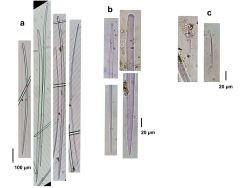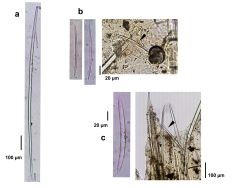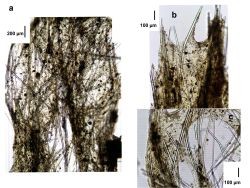orange
orange-yellow
massive
tough
Colombia
Panama
Dictyonella sp.2-"with oxea"
Description: Massively encrusting, up to about 10 cm in lateral size and 2-3 cm in thickness. The surface is hispid, sometimes even with a rather transparent pinacoderm stretched over internal columns of tissue, sometimes forming irregular protuberances; oscules scattered, up to about 0.5-1 cm in diameter, with a raised transparent collar. Out of the water the pinacoderm collapses and the surface becomes more hispid and irregular. Color orange to orange-yellow. Consistency toughly compressible. Ectosome organic, supported by the ends of ascending spicule tracts and brushes. Skeleton conformed by plumose tracts 2-3 to up to 7-10 spicules thick, reaching 380 µm in thickness, rather irregular, diverging and interconnecting as they grow upwards; there are many spicules strewn in confusion throughout the choanosome. Spicules are rather long and slender styles, slightly to strongly curved, 800-1300 µm long and 7.5-27.5 µm thick, with stair-stepped ends; there are thin (2-2.5 µm thick) developmental stages. Upon closer inspection of tissue thick sections and then of spicule preparations, we found a few scattered small fusiform, slightly curved oxea, 35-127 µm long by 1-5 µm thick. One specimen had some longer hastate oxea, 115-227 µm by 7-11 µm, which may not be proper.
Notes: We have observed this species in shallow and deep reef sites, on rubble or gorgonian branches, at Santa Marta, Colombia and Bocas del Toro, Panama. After some discussion with the authors of Redmond et al. (2013), we concluded that our samples could be conspecific with their unidentified P136 specimen, which in their phylogenetic analysis using small-subunit ribosomal DNA (18S) sequences fell within the Family Dictyonellidae-Bubaridae. We have for the time being placed this species in the genus Dictyonella, as its characteristics fall into the current definition of this genus (van Soest at. al., 2002), but for the presence of the small oxea. There are other orange and hispid sponge species that could be confused in the field with this species, such as those depicted here under the genus Auletta, and Dragmaxia undata Alvarez, van Soest & Rützler, 1998; besides subtle differences in shape, the very long styles megascleres, and possibly the presence of small oxea help distinguish this species from the others.

![<i>Dictyonella </i> sp.2-"with oxea" <br />[Colombia, Santa Marta]](mini/00115/01842.jpg)


